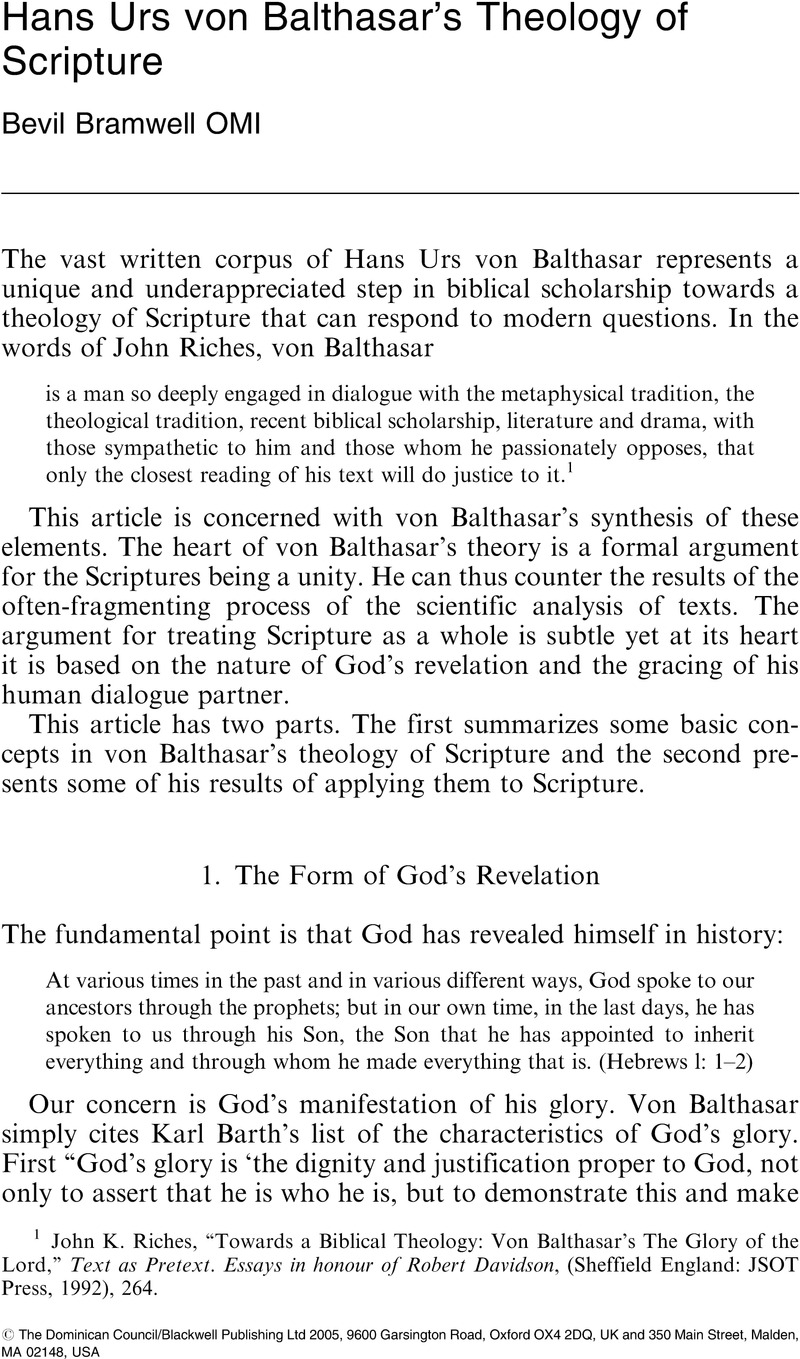No CrossRef data available.
Published online by Cambridge University Press: 01 January 2024

1 Riches, John K., “Towards a Biblical Theology: Von Balthasar's The Glory of the Lord,”Text as Pretext. Essays in honour of Robert Davidson, (Sheffield England: JSOT Press, 1992), 264Google Scholar.
2 Balthasar, Hans Urs von, The Glory of the Lord VII, Leiva‐Merikakis, Erasmo and McNeil, Brian C.R.V. trans., (San Francisco: Ignatius Press, 1989), 21CrossRefGoogle Scholar. The volumes of this series will be referred to by the abbreviation GL followed by the page number.
3 GL I, 468.
4 Balthasar, Hans Urs von, “The Word, Scripture and Tradition,”Explorations in Theology I. The Word made Flesh, Littledale, A.V. with Dru, Alexander trans., (San Francisco: Ignatius Press, 1989), 11Google Scholar. This article will be referred to as WST.
5 GL I, 29. Cf. TD II, 111.
6 GL VII, 115.
7 GL VII,13.
8 Cf. “Theological A priori of the Philosophy of Beauty” in GL IV, 317ff.
9 GL I, 536.
10 Cf. GL I, 528. Also WST, 11.
11 Aidan Nichols writes of the “circumincession of Tradition, Scripture and Apostolic Office” in von Balthasar's vision. Nichols, Aidan O.P., Say it is Pentecost – A Guide through Balthasar's Logic, (Washington D.C.: CUA Press, 2001), 175Google Scholar.
12 Mark A. McIntosh calls this an “exegetical christology.” See Mark A. McIntosh, Christology from Within, 30.
13 WST, 17.
14 WST, 17.
15 See also John 21:25.
16 WST, 17.
17 Cited in GL VI, l0.
18 GL VI, 281ff.
19 GL VI, 281.
20 GL VI, 402.
21 GL VI, 402.
22 GL VI, 402.
23 GL VI, 403.
24 See GL VI.
25 GL VI, 268.
26 GL VI, 406. As Nichols explains in his longer and more substantial analysis: “A theological aesthetics cannot do justice to such a grace on the basis of the Old Testament alone for only in its successor covenant does the image of God come to coincide (in Jesus) with God's Word and thus become ‘subsisting grace.’” Nichols, Aidan O.P., The Word has been Abroad: A Guide through Balthasar's Aesthetics, (Washington D.C.: CUA Press, 1998), 190Google Scholar.
27 GL VI, 406.
28 GL I, 320.
29 GL VI, 53. The abbreviation P refers to the Priestly Source in the ‘Four Source Theory’ of the origins of the Pentateuch. Historically P is the last reworking of the earlier Pentateuch material. The other sources in the theory are known as ‘J,’ the Yahwist; ‘E’ the Elohist and ‘D’ the Deuteronomist.
30 GL VI, 216.
31 GL VI, 223.
32 GL VI, 232.
33 Von Balthasar argues that Paul himself notes a “radical caesura between the sphere of the promise and the sphere of fulfilment” this is based on his exegesis of 2 Corinthians 3:7–11. (GL VII, 26).
34 GL VI, 279.
35 GL VI, 303.
36 He reads polumeros(Hebrews I: 1) as ‘fragmentary’.
37 TD II, 99.
38 Nichols notes that “von Balthasar is curiously negative about both the capacity of the Old Testament materials to carry us any distance towards the specifically Christian doctrine of the Holy Spirit.” Aidan Nichols, Say it is Pentecost, 135.
39 GL VII, 115. Note particularly his footnote on the “false theology which rejects faith as methodologically dubious and irresponsible and subsumes the truth of the phenomenon which discloses itself, under and anthropological truth.”(Note 2 in GL VII, 115).
40 GL VII, 223.
41 GL VII, 297.
42 GL VII, 298.
43 GL VII, 209.
44 See McIntosh, Mark A., Christology from Within, (Notre Dame: University of Notre Dame Press, 1996), 29Google Scholar.